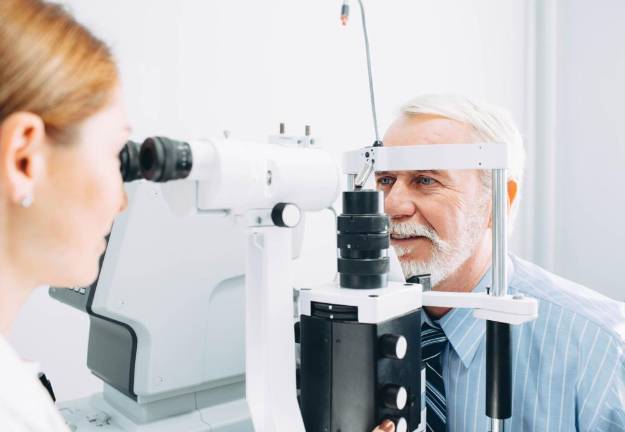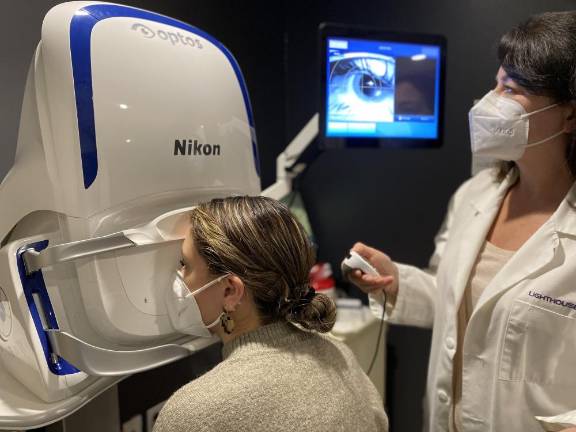Taking Care of Your Vision: Essential Tips for Older Adults
A doctor from Lighthouse Guild answers frequently asked questions about vision and eye health.


Like other organs in your body, your eyes do not stay the same as you get older. As you age, you will experience normal age-related changes to your vision. But there’s also an increased risk for certain eye diseases and conditions that can cause low vision and impact your quality of life.
The most important thing you can do to preserve your vision is to have a comprehensive dilated eye examination regularly. Following are some answers to commonly asked questions about vision and eye health.
What potential vision-threatening eye conditions can an eye exam detect?
Many, including:
• Cataracts, which cloud the lens in an eye.
• Diabetic eye disease, such as Diabetic retinopathy, which causes damage to the blood vessels in the back of the eye.
• Glaucoma, increased eye pressure that can damage the optic nerve.
• Age-related macular degeneration, which gradually affects central vision.
A more comprehensive list of eye problems and further information on vision and eye health can be found at lighthouseguild.org.
During an exam, if a doctor finds an issue, what can be done?
Several common eye problems can be corrected with glasses, contact lenses, or laser surgery. Millions of Americans would see better if they used corrective lenses or had corrective eye surgery, if appropriate. For people with low vision — vision loss that cannot be corrected with glasses, medication, or surgery — vision rehabilitation and technology can help with everyday tasks.
What other factors should be taken into account?
Being told you are losing vision can be overwhelming. Patients worry about losing their independence, particularly the ability to drive, and fear they will become overly dependent on others. Depression, anxiety, emotional distress, and sleep deprivation are common following diagnosis and may persist over time or recur as vision worsens. If you or a loved one begin to experience some of these symptoms, you should see a behavioral health expert.
What about devices?
The challenges for people who are visually impaired and blind are the focus of many innovators who have developed accessible technology, including wearable devices that convert text to speech, recognize faces, and identify currency; devices that use virtual reality technology to maximize functional vision; magnifiers, CCTVs, computers, and eyeglasses.
How can I protect my vision?
• Wearing protective eyewear when playing sports or doing activities around the home, such as painting, yard work, and home repairs.
• Wearing sunglasses that block 99-100 percent of ultraviolet A (UVA) and ultraviolet B (UVB) radiation.
• Quit smoking.
• Taking periodic eye breaks — staring at a computer all day, or any object, can make you blink less and cause eye fatigue. Follow the 20-20-20 rule: look away for 20 seconds every 20 minutes at something 20 feet away, which can reduce eyestrain.
• Eating healthy foods that protect your sight, such as dark leafy greens and fish high in omega-3 fatty acids.
• Knowing your family’s eye health history — since some eye conditions are hereditary.
I enjoy being physically active. Do you have any specific sport-related safety suggestions?
• Wear protective eyewear with shatterproof polycarbonate lenses for sports such as golf and pickle ball. Polycarbonate lenses provide the best protection because they can withstand the impact of a ball or other projectiles traveling up to 90 miles per hour.
• When snow or water skiing, wear protective glasses or goggles with UV protection to shield your eyes from sunburn and glare.
• Wear sports goggles over eyeglasses and contact lenses. Eyeglass lenses might shatter when hit by a flying object. Contact lenses offer no protection.
• Replace old protective eyewear that is scratched, damaged in some other way, or yellowed with age.
• Do not treat a cut or punctured eye on your own. Don’t remove an object stuck in the eye or touch, rub, or apply pressure to the eye. Seek immediate medical help, as a mishandled injury could result in permanent vision loss or blindness. In the meantime, gently taping a shield, like the bottom of a paper cup, over the bones surrounding the eye can protect the area until you get medical attention.
Laura Sperazza, OD, is Director of Vision Rehabilitation Services at Lighthouse Guild.